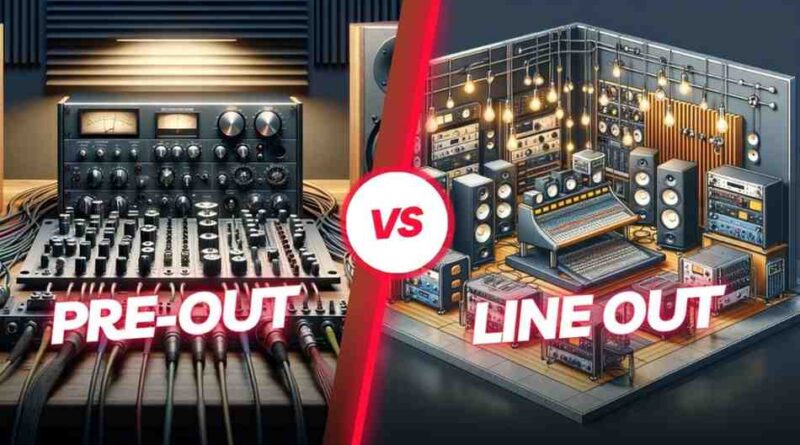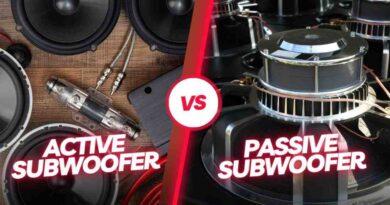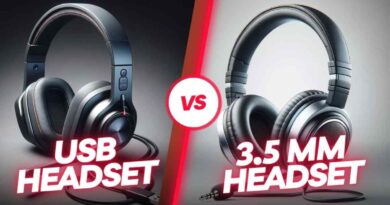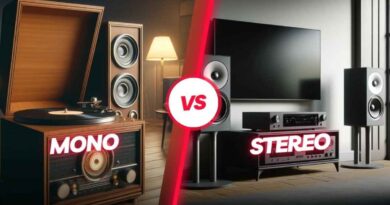Pre-Out Vs. Line Out (Making The Right Choice)
When setting up audio systems, whether for a home theater, studio, or live performance, you often encounter a variety of connections and outputs. Two common terms you’ll come across are “Pre-Out” and “Line Out.” Though they might sound similar, they serve different purposes in audio equipment setups. Understanding the differences between these outputs can greatly impact the quality and control of your audio system. In this blog, I’ll break down everything you need to know about Pre-Outs and Line Outs to help you make the best choice for your audio needs.
What is Pre-Out?
Pre-Out connections are essential in audio systems where you need control over volume and sound processing before the signal reaches the final amplification stage. Here’s what you should know:
- Functionality: A Pre-Out sends a variable signal from an audio receiver or processor to an external amplifier. It is affected by the receiver’s volume and tone controls. This means you can adjust the audio signal’s volume and tonal quality before it’s amplified.
- Usage Scenarios: Pre-Outs are ideal for systems requiring multiple amplifiers or when using power-hungry speakers that benefit from dedicated amps. They allow for more flexibility in adjusting the audio output based on different zones or speaker setups in a multi-room or theater system.
- Technical Specs: Typically, Pre-Outs operate at line level with voltage ranging from 1 to 2 volts, which is ideal for input into a power amplifier. The exact specifications can vary, so checking compatibility with your amplifiers is crucial.
Key Takeaways:
- Pre-Outs offer control over volume and sound quality before amplification.
- Ideal for complex setups with multiple amps or high-power requirements.
What is Line Out?
Line Out ports are another common feature in audio equipment, but they serve a different function compared to Pre-Outs. Understanding their characteristics is key:
- Functionality: Line Out provides a fixed audio signal from the device. It does not allow for volume control or tone adjustments from the sending device; these controls are managed by whatever equipment the Line Out is connected to.
- Usage Scenarios: This output is perfect for simple connections where no additional volume modulation is needed between devices. It’s typically used to connect audio sources to recording equipment or more permanent setups where volume levels are controlled elsewhere.
- Technical Specs: Line Out also operates at line level but sends a constant voltage (often around 1 volt), independent of the source device’s volume control.
Key Takeaways:
- Line Out delivers a fixed audio signal, perfect for direct recording or system integration.
- Best used in setups where volume control is managed by external amplifiers or mixers.
Pre-Out Vs. Line Out
Comparing Pre-Out and Line Out
When deciding between Pre-Out and Line Out, consider what you need in terms of control and the role of each component in your audio setup. Here’s a detailed comparison:
Control Flexibility
- Pre-Out: Offers extensive control over the audio signal, including volume and tonal adjustments, before it reaches the amplifier. This is crucial for fine-tuning audio in high-end audio systems or multi-room setups.
- Line Out: Provides no control over the audio signal from the source, requiring adjustments to be made on the amplifier or the next component in the chain.
Ideal Usage
- Pre-Out: Best for audio enthusiasts and professionals who need precise control over their sound across different speakers and zones.
- Line Out: Suitable for simpler setups or professional environments where the audio signal needs to be unaltered by the source device.
Technical Considerations
- Pre-Out: Requires careful consideration of the matching amplifier’s input sensitivity to ensure optimal sound quality and prevent distortion.
- Line Out: Easier to manage in terms of technical compatibility, but it limits the ability to adjust sound at the source.
Benefits of Using Pre-Out
Choosing Pre-Out offers several advantages:
- Enhanced Audio Control: Allows for adjusting volume and sound settings before amplification, giving you more granularity in sound management.
- Versatility in Audio Management: Facilitates the use of multiple amplifiers, which can be tailored to different speakers or audio zones for a customized audio experience.
- High Compatibility: Works well with high-end amplifiers designed to handle variable inputs, making it ideal for audiophiles and professional setups.
Benefits of Using Line Out
Line Out also has its merits:
- Consistency in Audio Signal: Delivers a consistent audio level, ensuring that the signal remains unchanged regardless of the source’s volume setting.
- Simplicity and Reliability: Less complicated to set up and use, as it bypasses internal volume and tone controls.
- Ideal for Recording: Provides a clean signal ideal for recording purposes, where maintaining audio integrity from the source is critical.
Situational Comparison: When to Use Each
- Home Theaters: Pre-Out is generally preferred for home theaters, allowing for detailed audio adjustments and customization with external amplifiers.
- Professional Recording: Line Out is typically used in recording studios where maintaining the integrity of the original audio signal is paramount.
- Live Sound Systems: Depending on the complexity, Pre-Outs might be used for main speakers with additional amps, while Line Out could be ideal for direct feeds to recording equipment or broadcast systems.
Conclusion
Choosing between Pre-Out and Line Out depends largely on your specific audio needs. If you require precise control over sound across various outputs and setups, Pre-Out is the way to go. It allows for detailed adjustments and can cater to complex audio systems. On the other hand, if you need a straightforward setup without the need for volume modulation at the source, Line Out will serve you well, especially in professional recording environments where signal integrity is crucial.
In conclusion, assess your audio system’s requirements, consider the type of control you need over your audio, and choose accordingly. Both Pre-Out and Line Out have their places in audio setups; picking the right one will enhance your audio experience and system functionality.
Frequently Asked Questions
What is Pre-Out used for?
Pre-Out is used to send a variable audio signal to external amplifiers, allowing for volume and tone control before amplification.
What is Line Out used for?
Line Out provides a fixed audio signal to other audio equipment, ideal for recording or when volume control is managed elsewhere.
Can I use both Pre-Out and Line Out at the same time?
Yes, in some audio systems, you can use both outputs simultaneously for different purposes, such as one for recording (Line Out) and another for live sound amplification (Pre-Out).
Does using Pre-Out affect sound quality?
If properly matched with amplifier input sensitivity, Pre-Out should not negatively affect sound quality and can actually enhance it by allowing for better signal management.
Is Line Out better for professional recording?
Yes, because it provides a consistent, unaltered signal that maintains the original audio integrity, which is crucial in professional recording settings.
How do I connect Pre-Out to an amplifier?
Connect Pre-Out to an amplifier using RCA cables, ensuring that the amplifier’s input sensitivity matches the output signal for optimal sound quality.
What should I consider when choosing between Pre-Out and Line Out?
Consider the level of control you need over the audio signal and whether you require the ability to adjust the sound at the source or not.
Can Line Out be used with any amplifier?
Yes, Line Out can be used with any amplifier, but it’s important to note that all volume and tone control must be managed by the amplifier or subsequent audio processing equipment.
Are there devices that offer both Pre-Out and Line Out?
Many modern audio receivers and mixers offer both Pre-Out and Line Out options to accommodate different audio setup requirements.
How does Pre-Out impact a multi-room audio system?
Pre-Out allows for individual volume and sound control in different rooms, making it ideal for multi-room audio systems where different zones may have different audio requirements.




